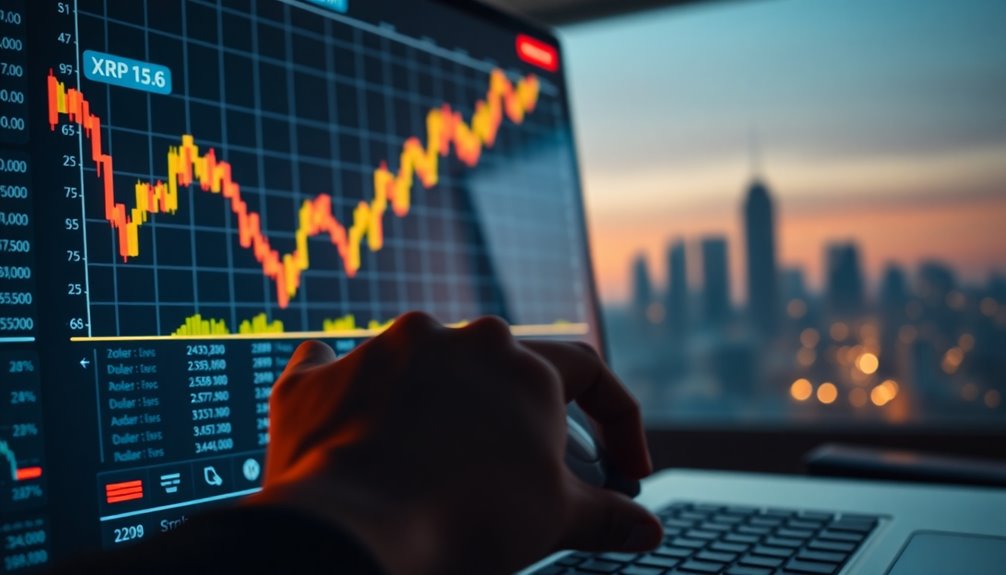If you're looking to invest in XRP, now's a pivotal moment. Insider reports hint that XRP could hit the $10 mark sooner than you think, fueled by strong market sentiment and ongoing legal developments with Ripple. Currently priced around $2.56, its trajectory suggests potential gains driven by regulatory clarity and increasing adoption. With a bullish market and significant whale activity boosting confidence, missing out now could mean losing your chance. Stay tuned, as the next few months may reveal crucial insights on how to position yourself for this potential breakout.
Key Takeaways
- XRP has the potential to reach $10 by early 2025, driven by positive market sentiment and Ripple's growing adoption.
- The ongoing legal developments in Ripple's SEC lawsuit could significantly impact XRP's price trajectory and market confidence.
- Recent bullish trends, including a breakout pattern and increased trading volumes, indicate a potential rally towards the $10 mark.
- Market sentiment is currently strong, with a Fear & Greed Index at 74, reflecting investor optimism about XRP's future.
- Significant whale activity, including large purchases of XRP, suggests strong confidence in the cryptocurrency's price appreciation.
Current XRP Price Overview

As of December 18, 2024, XRP is trading at $2.556, marking a 1.54% increase from the previous day's price of $2.494. This upward movement reflects a significant change from just a year ago when XRP was priced at $0.61, illustrating an impressive 308.8% increase.
In December 2024, XRP's price has fluctuated between $1.91 and $2.56, showing some volatility but maintaining a mostly positive trend with 18 out of the last 30 days being green. Over the past week, XRP has gained 6.7%, reinforcing the bullish sentiment in the market. Currently, the Fear & Greed Index scores a notable 74, indicating a prevailing sense of 'Greed' among investors.
This positive sentiment follows a strong performance in late November, where XRP's price doubled, crossing the crucial $1.50 mark. Historically, XRP has shown resilience, breaking through resistance levels that held it back in 2022 and 2023. Additionally, its current price represents a remarkable 317.3% annual change from the previous year, highlighting the strong growth trend.
As you navigate the market, keep an eye on these trends, as they could signal further opportunities for growth in the near future.
Market Position and Rankings

XRP's impressive performance has solidified its position within the cryptocurrency market, now ranking third in market capitalization behind Bitcoin and Ethereum. With a market cap of approximately $151 billion, XRP has surpassed Tether (USDT), which now holds the fourth position with a market cap of $140 billion.
This achievement reflects XRP's market share of about 4.01% of the total cryptocurrency market capitalization, which recently soared to nearly $3.95 trillion. XRP reached a high of $2.60, significantly contributing to its rise in market cap.
Bitcoin dominates the market with a staggering $2.1 trillion market cap, accounting for 54% of the total, while Ethereum follows with $479 billion and about 12.72% market share.
XRP's recent surge of over 9% was fueled by the announcement of Ripple's RLUSD stablecoin, pushing its price up to a multi-day high of $2.60. In comparison, Solana (SOL) ranks fifth with a market capitalization of $109 billion.
The overall market sentiment has improved, driven by positive regulatory developments and legal progress for Ripple, leading to increased investor enthusiasm.
As XRP continues to climb the ranks, it's essential to keep an eye on its performance relative to other major cryptocurrencies.
Technical Analysis Insights

Technical analysis reveals a mixed outlook for XRP, with several indicators suggesting both bullish and bearish sentiments. The 5-day and 20-day moving averages signal a buy at 2.34 and 2.07, respectively, while the MACD line also supports a bullish stance. Additionally, the overall trading signal for XRP is a strong buy, indicating a potential upward trend.
However, the Stochastic Oscillator sits at 50.80, indicating neutrality, and the RSI at 62.13 shows bullish divergence yet remains neutral overall. Chart patterns further complicate the picture. A bullish harami is visible in shorter timeframes, but bearish trend reversals emerge in the 1-hour and 2-hour charts.
XRP's position below the pivot point hints at bearish momentum, while it flirts with the upper boundary of a flag channel, needing to break this resistance to initiate a rally. In terms of momentum, indicators show bearish tendencies, with the momentum indicator below zero in daily and 4-hour timeframes.
Liquidations have recently impacted market dynamics, yet funding rates returning to normal could spark a bullish move. Ultimately, XRP's short-term outlook remains uncertain, potentially swinging between liquidity grabs and significant rallies.
Historical Performance Review

Understanding XRP's historical performance offers valuable context for its current market behavior. In early 2018, XRP reached an all-time high of $3.84, riding the wave of broader cryptocurrency market euphoria. At that point, it boasted a market capitalization of $139.4 billion, making up 20% of the entire crypto market.
However, the excitement didn't last. A significant downturn in December 2018, driven by regulatory uncertainties and major delistings, saw XRP plummet to around $0.50, shrinking its market cap to just $26.29 billion.
Fast forward to November 2024, and XRP made headlines again, surging 281% to reach $2 for the first time in nearly seven years. This resurgence pushed it back into the spotlight as the fourth-largest cryptocurrency, with a market cap exceeding $122 billion. Additionally, recent market trends indicate that XRP's rise has been supported by a bullish flag breakout, further boosting investor confidence.
Investor optimism grew, fueled by the anticipation of a favorable outcome in Ripple's ongoing legal battle with the SEC and the potential approval of a spot ETF.
Throughout these fluctuations, historical performance hasn't only set benchmarks but also shaped investor sentiment, leading to increased interest and activity within the XRP community.
Regulatory Impact on XRP

The regulatory landscape surrounding XRP has become a pivotal factor influencing its market dynamics. The ongoing dispute between the SEC and CFTC over XRP's classification is crucial for its future. The SEC contends that XRP is a security, while the CFTC views it as a commodity. This disagreement directly impacts how XRP futures can be traded and whether they can be listed on exchanges.
Currently, XRP's unregistered status complicates its inclusion in futures markets and ETFs, as the SEC's interpretation necessitates registration as a security. Notably, Bitnomial's efforts to trade XRP futures highlight the challenges presented by the regulatory gap surrounding digital assets.
The lawsuit against Ripple Labs, initiated by the SEC in December 2020, is a defining moment for cryptocurrency regulation. Its outcome could set a significant precedent for how digital assets are treated in the U.S. Furthermore, the lack of clear regulatory guidelines creates a challenging environment for innovation.
If the SEC's stance remains unchanged, exchanges like Bitnomial face barriers to listing XRP products without risking enforcement actions.
As you navigate the crypto landscape, be aware that regulatory uncertainties surrounding XRP can significantly impact your investment strategies and market opportunities. Keeping an eye on these developments could prove essential for your financial decisions.
Analyst Predictions for XRP

As analysts dive into XRP's future, their predictions paint a varied picture for investors. For 2024, you're looking at an average price ranging from $0.892 to $2.37, with minimums likely between $0.4239 and $1.75. The maximum predictions stretch up to $2.77, but some forecasts, like those from CoinDCX, suggest a tighter range of $0.75 to $0.85.
Meanwhile, LiteFinance hints at a sideways trend down to $0.30.
Shifting to mid-term predictions for 2025, analysts expect an average price between $1.32 and $1.48, reflecting a potential growth of nearly 48% from 2024. The minimum price could dip to around $0.92, while the maximum peaks at $2.58. This potential growth is supported by Ripple's decentralized money transfer network, which enhances transaction efficiency.
Looking further ahead, long-term predictions for 2030 are even more optimistic. Analysts anticipate a minimum of $6.15 and a maximum of $16.24, with an average of about $8.15, indicating a robust growth trend.
Many believe XRP could hit that coveted $10 mark by early 2025, thanks to positive market sentiment and increased adoption of Ripple’s payment solutions. This optimism is also fueled by various xrp price predictions from industry experts, which suggest that the digital asset has the potential for significant growth in the coming years. Additionally, with Ripple’s partnerships with major financial institutions and its focus on innovation and efficiency in the world of cross-border payments, XRP’s potential for reaching the $10 mark seems increasingly likely. As the cryptocurrency market continues to evolve, it is evident that XRP’s utility and value could continue to rise, bringing it closer to reaching this important milestone.
Recent Developments and News

Ripple's ongoing legal battle with the SEC has become a focal point for the cryptocurrency market, stirring both concern and optimism among investors.
As the SEC appeals a 2023 court ruling that determined XRP isn't a security, Ripple is also filing a cross-appeal regarding certain SEC classifications. This legal tug-of-war is expected to stretch into 2025, leaving many wondering about its long-term impact on crypto regulation. Additionally, the outcome of this case could significantly impact digital asset regulation in the U.S.
In the midst of this uncertainty, there's growing criticism over the SEC's unclear crypto regulations. Investors are calling for clarity, especially in light of potential changes in SEC leadership, which could lead to a more crypto-friendly environment.
Meanwhile, Ripple has allocated $125 million in escrow for potential case outcomes, showcasing its commitment to addressing legal challenges.
On the market front, XRP has witnessed a remarkable surge, climbing over 362% in the past month amid positive regulatory news.
Current trading volumes have soared, with XRP overtaking major tokens like Solana and Binance Coin.
With the anticipated launch of Ripple's stablecoin, RLUSD, and strong bullish momentum indicated by technical analysis, XRP's future looks increasingly promising.
Market Sentiment Trends

Market sentiment trends surrounding XRP have shifted dramatically in recent weeks, fueled by a mix of legal developments and growing investor interest. You can see this shift reflected in social media discussions on platforms like X, Reddit, and Telegram. Increased positive mentions suggest a bullish sentiment, while the frequency of these discussions signals rising investor engagement.
Recent legal progress, particularly regarding the SEC lawsuit against Ripple, has further boosted sentiment. As media coverage highlights pro-crypto figures and their regulatory roles, the market mood leans increasingly positive. Additionally, upcoming events such as the RLUSD stablecoin launch are generating buzz, enhancing optimism among investors. The recent acquisition of 30 million XRP tokens by whales indicates strong investor confidence and highlights significant buying pressure in the market.
From a technical standpoint, XRP's charts show promising signs. The breakout from a bullish flag and pole pattern on the daily chart, along with a seven-year bullish pennant on the weekly chart, indicates potential for significant price surges. The Relative Strength Index at 66 suggests that there's still room for growth.
Moreover, a 41% spike in trading volume reflects heightened investor participation, creating a greedy market sentiment. All these factors contribute to a bullish outlook for XRP, making this an exciting time for potential investors.
Potential Risks and Challenges

Navigating the landscape of XRP investment involves recognizing the potential risks and challenges that could impact its future. One significant hurdle is the ongoing regulatory uncertainty. The SEC's classification of XRP as a security complicates its potential for ETF and futures listings, creating a catch-22 situation. Without registration as a security, XRP can't be listed, yet compliance with the SEC's interpretation feels unfeasible.
Macroeconomic factors also play a role. Rising interest rates and economic uncertainties can affect investor confidence, leading to volatility in crypto prices. Global downturns could further dampen market stability, making it essential to stay alert to shifting economic conditions. Recently, XRP's market cap reached $154 billion(154 billion), indicating a surge in interest that could also alter investor sentiment.
Additionally, technical and market risks are ever-present. The crypto market is known for its volatility, where rapid price fluctuations can occur. Hype fatigue may set in, causing market sentiment to shift unexpectedly. Whale activity can influence price movements, and speculative trading can contribute to instability.
Finally, legal and compliance risks remain a concern. The SEC's ongoing appeal against Ripple Labs and potential regulatory surprises could impact XRP's future, making it crucial to stay informed about these evolving dynamics.
Final Thoughts on XRP's Future

As the landscape for XRP investment continues to evolve amidst regulatory uncertainties and macroeconomic factors, it's clear that the future holds both promise and volatility.
With XRP recently reaching a 3-year high of $1.2 and more than doubling its value in just a week, you're witnessing strong short-term momentum. The bullish sentiment is reinforced by record open interest in futures contracts, suggesting new capital is entering the market. Additionally, the launch of Ripple-backed stablecoin RLUSD on Dec 4, 2024, could enhance XRP's utility and market presence.
The ongoing SEC lawsuit remains a pivotal factor. A favorable outcome could significantly enhance investor confidence and open doors for institutional involvement.
As regulatory frameworks become clearer, XRP's adoption through partnerships with banks in Europe and Latin America could further solidify its position in the market.
Long-term price predictions are optimistic, with forecasts indicating that XRP could reach between $5 and $16.24 by 2030.
If you're considering an investment in XRP, staying informed about regulatory developments and market trends is crucial.
While risks persist, the potential for growth and adoption makes XRP an attractive option for both retail and institutional investors looking to capitalize on the evolving crypto landscape.
Frequently Asked Questions
What Factors Could Lead to XRP Reaching $10?
To see XRP reach $10, you should watch for positive legal developments, like favorable outcomes in the Ripple vs SEC case and potential ETF approvals.
Increased adoption of Ripple's payment solutions and growing institutional interest will also boost demand.
Keep an eye on market trends; if investor sentiment remains strong and trading volumes continue to rise, XRP might just hit that target.
Technical indicators are suggesting a bullish long-term trend too.
How Does XRP Compare to Other Cryptocurrencies?
When you compare XRP to other cryptocurrencies, you'll notice significant differences in transaction speed, cost, and decentralization.
XRP confirms transactions in just 3-5 seconds with minimal fees, making it ideal for cross-border payments. In contrast, Bitcoin can take around 10 minutes and has fluctuating fees.
While Bitcoin's decentralized nature appeals to security-focused users, XRP's centralized control by Ripple Labs offers efficient solutions for businesses, especially in international transfers.
What Role Do Partnerships Play in Xrp's Growth?
Partnerships play a crucial role in XRP's growth by enhancing its use cases and boosting adoption.
When you see Ripple collaborating with banks and payment providers, it accelerates cross-border transactions and increases liquidity.
These alliances also emphasize regulatory compliance, building trust and confidence among investors.
As partnerships expand, they contribute to a positive market sentiment, ultimately driving demand for XRP and increasing its value in the competitive crypto landscape.
How Can Investors Mitigate Risks With XRP?
To mitigate risks with XRP, you should store most of your assets in cold wallets rather than exchanges, which reduces exposure to hacks.
Use strong passwords and enable two-factor authentication for added protection.
Diversify your investments across various cryptocurrencies and asset classes to spread risk.
Keep an eye on market volatility and set stop-loss orders to limit potential losses.
Staying updated on regulatory changes will also help you navigate the evolving landscape.
What Events Could Trigger a Price Drop for XRP?
Several events could trigger a price drop for XRP.
If a massive sell order hits the market, it can lead to abrupt declines due to thin order books.
Regulatory challenges, like negative SEC rulings, might also create uncertainty, pushing prices down.
Additionally, if Bitcoin struggles at resistance levels, XRP often follows.
Lastly, profit-taking by large investors after significant rallies can increase selling pressure, leading to potential price corrections.
Conclusion
In conclusion, XRP's potential to hit $10 is fueled by market trends, technical analysis, and recent developments. However, it's crucial to stay informed about regulatory changes and market sentiment as these factors can significantly impact your investment. While the future looks promising, remember that risks exist, and nothing is guaranteed. If you're considering jumping in, keep an eye on the market and make informed decisions. This could indeed be a pivotal moment for XRP.










